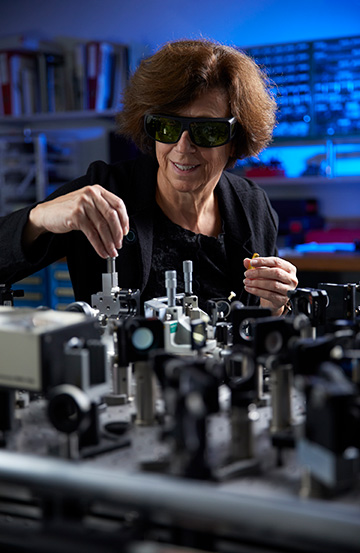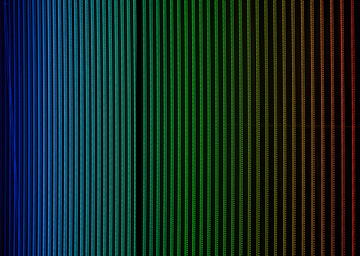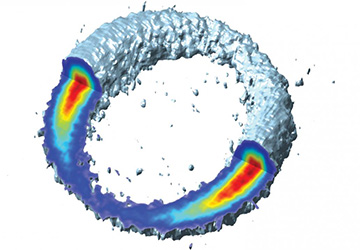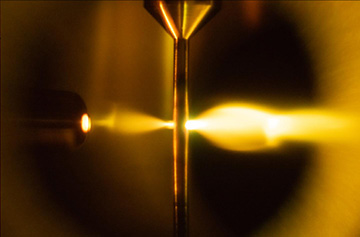
Ursula Keller. [Image: European Patent Office]
For its May 2020 print article “The Laser at 60,” OPN interviewed a range of OSA Fellows to get their insights on some particularly interesting horizons in laser research today. We’re presenting a selection of those interviews online. Below is an edited version of our interview with Ursula Keller of ETH Zurich, Switzerland.
Keller, the winner of OSA’s 2020 Frederic Ives Medal/Jaris W. Quinn Prize, has been at the front ranks of scientists pushing laser pulses to ever shorter timescales, and thereby to illuminate ever-finer-scale processes in chemistry and physics. Her accomplishments range from the invention of the semiconductor saturable absorber mirror (SESAM), which enabled passive mode-locking of diode-pumped solid-state lasers, to frequency-comb stabilization, to advances in few-cycle pulse generation—all of which have driven or enabled key advances in attosecond science.
You’re at the forefront of many advances in lasers. What do you personally view as some of the most interesting things being done today in laser science and technology?
When you look at how laser performance has been evolving over the 60 years, it’s just amazing—in terms of average power, in terms of pulse duration, in terms of bandwidth and so on. I don’t really see how the progress of the laser in all directions—in industrial applications, in computing, in fundamental science—is coming to an end.
When you look at electronics, for example, photonics is becoming stronger and stronger with the help of the laser—the electrical cables are now being replaced by optical cables, and ultimately optics will go deeper and deeper into the computing architecture. I think photonics and electronics are merging. Every single iPhone has now a laser—not an LED, a laser, multiple lasers, in every single hand. That is really impressive to me.
And for me personally, of course, the ultrafast laser has made tremendous progress. In the 1970s everything was done with dye lasers—that was the frontier. You had to babysit the laser for the whole day, and at the end you could do an experiment. Now, with solid-state technology, we have much more reliable ultrafast lasers at many wavelengths, much higher power levels and much better performance.
Let’s talk bit more about ultrafast, and the work you’ve done in few-cycle and subcycle pulses over the years. Why is it important to get these few-cycle pulses—both scientifically and industrially?
When I started off after my Ph.D., the Ti:sapphire laser was invented by Peter Moulton. That was the first solid-state laser that had the necessary bandwidth to support these few-cycle pulses, and that really started a whole different generation of ultrafast laser research. Within a very short time, we pushed it into this few-cycle regime.
Initially, it was simply curiosity driven—we just wanted to know, How far and how short do we get this? But then we also realized that the electric field underneath the pulse envelope is not stabilized—the electric-field distribution underneath the pulse envelope is a random, fluctuating thing from pulse to pulse, and the field strength varies drastically from pulse to pulse. So if you do nonlinear optics, you just generate noise.
At that time, we considered solving the problem of stabilizing this electric field underneath the pulse envelope as a holy grail. We had a Gordon Conference where we discussed this. And ultimately, solving this not only solved the stability problem, but actually started the whole frequency-metrology revolution.
So for me this is just one of those examples—if you push a technology to the frontier, to the limits, you normally stumble on something which you don’t even expect, and that can open up a totally new field. In the old days, the frequency-metrology people and the ultrafast people were not sharing any conferences, because the frequency metrology wanted to have narrow bandwidth, and the ultrafast wanted broad bandwidth.

Keller’s work stabilizing the electric field beneath the pulse envelope in few-cycle pulses, via frequency combs, helped open up a revolution in frequency metrology. [Image: European Southern Observatory (ESO); CC-BY-4.0]
And through the frequency comb—because the stabilization solution was basically done with the frequency comb, which we did in collaboration with Telle in 1999—that basically fused these two communities together for the first time. And so it’s just one of those examples where if you push a performance of a laser into a regime where it never has been before—well, something new always pops up.
Where are you going with this work now? Are you pushing things further in your current work?
Yes! One recent invention in my group that gets me excited is dual-comb mode locking. This is a very simple way, with an additional birefringent crystal in the laser, to produce two mode-locked pulse trains which have a different repetition rate. And if you have two periodic systems which have a little bit different repetition rate, you can sample one and the other. Actually, it’s a very similar technique that we already used when I did my Ph.D.—we called it equivalent time sampling, and it’s very well known from the microwave domain.
The challenge in all the dual-comb applications before was that you needed to stabilize the full frequency comb from two separate lasers, which requires four feedback loops. In dual-comb mode locking, now suddenly you create everything out of one laser. You have much higher stability, so it enables even measurements without any stabilization with sufficient performance.
Just before we talked today, I was in the lab and my group showed me their latest results with a nice femtosecond dual-comb laser. They were able to measure the recovery time of a SESAM within less than a microsecond—you can see it on the scope! The full time-resolved measurement, in one shot—which, when you do it the normal way, with pump-and-probe measurement, you have to step through the delay between these two pulses and then you get finally the measurement. With this dual-comb technique, you get it without any delay stages and extremely fast—simply inversely proportional to the difference in pulse repetition rate. So one measurement takes typically around 1 µs to 1 ms.
So does that kind of flexibility and those kinds of fast sampling measurements have implications for the kinds of things one does with studies of molecular and atomic processes, for example?
Yes. You can do any kind of relaxation processes—you can do lidar; you can do any kind of measurements now with these kind of lasers, but much faster. So you can actually think of doing the recovery time of dyes. Certain biological systems have different recovery times, but when you have to make a long measurement [as in pump/probe experiments], you’re limited. But if you now can do it in a microsecond with only one simple laser there will be a bunch of new applications.
That has us very excited right now. We have all the fundamental patents now on this dual-comb mode locking, and I have a group of people who want to start a company on that.
Another thing that I’ve heard about recently is the concept of the “attoclock.” What steps forward in laser technology have been necessary for that technique?

Keller’s group used the “attoclock”—in which the rotating electric-field vector in circularly polarized light acts like a stopwatch at attosecond scales—to reconstruct the 3D momentum distribution of excited photoelectrons. [Image: ETH Zurich, D-PHYS, Keller group]
This was something else that we were only able to invent by that carrier envelope offset stabilization that I talked about before—where we push the pulse duration into the few-cycle limit, and then we have to stabilize the electric field underneath the pulse envelope. We solved that problem by realizing that we had to go to the frequency domain, via the mode-locked frequency comb.
The frequency comb from a mode-locked laser has two degrees of freedom, the comb spacing and the comb offset. The comb spacing was stabilized by my Ph.D. adviser at Stanford for the first time, and I learned everything about that during my Ph.D. thesis work. The comb offset stabilization we demonstrated the first time as described above.
And it turns out that you can translate that into the circular polarization. With a circular polarized pulse, the electric-field vector rotates a full 360 degrees once per optical cycle, and the vector length slowly increases, reaches a maximum and then goes down again. The direction that the maximum of the electric field is pointing to is set with the frequency comb offset. So you can use the rotating electric field vector as the time reference, similar to the hand of a clock.
And we realized that basically, because we could stabilize the maximum field vector in space, we could take this maximum, and say, “Okay; this is our time zero—we set this to 12 o’clock.” So the position of the electric-field maximum is our time zero in our “stopwatch.” For example at the electric-field maximum we can start a tunneling process —a highly nonlinear process for which the tunneling rate depends exponentially on the electric field strength. And then we look at what direction at which most electrons come out, and that direction, by comparison with this fast-rotating electric field—our stopwatch—gives us the time reference and therefore the tunneling time.
Hence the name “attoclock.”
Right—that’s why we called it an attoclock; because the electric field rotates like the hands of a clock. You start the time zero, and then afterwards you just measure electron momentum—in what direction are the electrons flying. And since the hand of the clock, the electric field vector, at a center wavelength of 800 nanometers is fully rotating in 2.7 femtoseconds, you have attosecond accuracy by degrees of direction.
Speaking of attoseconds, I wanted to talk about a paper you recently published in Optica. Repetition rate seems to be another parameter that’s very important in lasers driving attosecond science, and in high-intensity lasers as well. Could you talk a little bit about that parameter’s importance?

In a recent paper in Optica, Keller’s group reported research that substantially boosted the repetiton rate of soft X-ray pulses from high harmonic generation (HHG). In this photo, HHG is driven in a high-pressure gas cell, with the mid-infrared input arriving on the right and the soft-X-ray output appearing on the left. [Image: ETH Zurich, D-PHYS, Keller group]
To get to these attosecond pulses, we basically use high-harmonic generation (HHG). HHG in principle is very inefficient—typically 10–6; maybe you can push it to 10–4. So you have to come in with pretty strong [pump] pulses to do the nonlinear frequency conversion to get to these high harmonics.
Now, the pulse energy that you get into these high harmonics is not that much—it comes normally from an amplifier system that works at repetition rates in the kilohertz or maybe 10 kilohertz. So, if you have nanojoule pulses at low repetition rate, that gives you a pretty low average power. And the average power is relevant for signal to noise.
So if we want to do attosecond spectroscopy for example in condensed matter where we need to reduce space charge effects, we need better signal to noise—we need more nanojoule attosecond pulses at a higher repetition rate. And that’s why we’re pushing all these short-pulse, high-power lasers into higher repetition rates. In particular that’s why the Ti:sapphire laser is being replaced, more and more, by optical parametric chirped-pulse amplifiers (OPCPAs)—because OPCPA schemes can benefit from high average power industrial lasers.
A lot of industrial lasers are being developed in in the pico- and hundreds-of-femtoseconds regime, at one micron, for materials processing. And you can use these lasers with kilowatts or hundreds of watts of average power to drive the OPCPA to get into the few-cycle regime at high repetition rates. So then you can do attosecond time-resolved structure analysis, watching not only how atoms are moving, but how electrons are moving.
Whereas, if you didn’t have those kinds of repetition rates, you simply wouldn’t be able to resolve that kind of thing?
Your signal to noise is just more limited. The signal to noise in those kinds of measurements goes with average photon flux. You can increase the photon flux by increasing the pulse energy, but for many measurements you don’t want to do that because you then have space charge effects; you cannot resolve the physics you want to actually probe. So you do it through repetition rate.
Is there anything else that your team is working on that you think looks particularly interesting?
Another field that is emerging is petahertz electronics. Now that we have essentially full control of the time-dependent electric field—from terahertz to petahertz—we can actually do everything that we have done in terahertz spectroscopy with much higher frequency. So we can actually explore the dynamics in materials at much higher frequency, and pave the way to faster and faster electronics.
One thing that’s jumped out at me again and again in this 60th anniversary year of the laser is the importance of diode-pumped solid-state lasers. What are your own thoughts on the importance of that technology, and how it’s changed things?
It has definitely enabled industrial applications. Diode-pumped solid-state lasers replaced flashlamp-pumped lasers, and with a flashlamp you pump the laser very broadly, because flashlamp is white. That means there’s a lot of heat that needs to be dissipated, because you pump so widely. Whereas with diode lasers, you pump with diode laser arrays—the optical beam quality is degraded, but the spectral property is very narrow. So you can pump directly into certain absorption lines, and hopefully have lasing with a very small quantum defect.
And that’s why these ytterbium-doped laser materials—diode-pumped ytterbium-doped laser materials—became so successful for the power scaling into the kilowatts. Whereas a Ti:sapphire laser is pumped in the green and lases in the red—that’s a huge quantum defect which has to be dissipated into heat. In addition you cannot increase the Ti3+ doping concentration too much to use it in an thin disk geometry. These are the reasons why the Ti:sapphire laser is just more limiting for power scaling.
And that’s why these ytterbium-doped materials gain so much power, commercial power for the average power scaling of diode-pumped solid-state lasers. It’s both that you pump spectrally very directly into an absorption line, and you keep the quantum defects between pump and lasing as small as possible.
One final question, which kind of something you said at the beginning of the interview. You’ve been active in this field for a long time. Are there things that surprise you about how far lasers have come? Things that you found just especially amazing or impressive?
I think I never could have predicted how fast the progress would be in attosecond science, and in the average power scaling of the lasers. It’s just amazing where we are. In the old days, we would have panels at conferences, asking, “How far do you think it’s going to go?,” and people would argue … It’s definitely interesting how it evolved.
In general, even as experts, I think we’re not very good at predicting the future—we always underestimate how fast progress will go in the long run, and always think things will go faster than they do in the short run. We underestimate in the long run because suddenly, there are discoveries you haven’t even thought of that can accelerate the field by orders of magnitude, and that pop up every so often. But those are not predictable.
So in between those events, things sometimes go pretty slowly. But then suddenly, there is a paradigm shift.
Thanks very much for giving me the time today, and congratulations on the amazing work that your group is doing.
Thank you—we are having a lot of fun!
